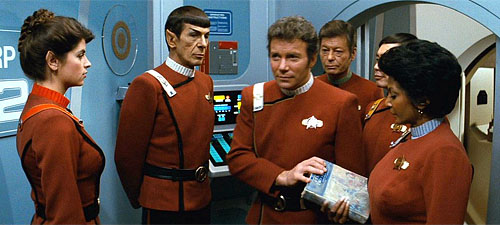 Ah, now here we have something. Star Trek II: The Wrath of Khan is what really drove me to continue this series of reviews into the films. It is widely regarded as the best of the original cast Star Trek films. Watching it again, I am reminded forcefully why this is the case.
Ah, now here we have something. Star Trek II: The Wrath of Khan is what really drove me to continue this series of reviews into the films. It is widely regarded as the best of the original cast Star Trek films. Watching it again, I am reminded forcefully why this is the case.
Although, the music over the credits is nowhere near as memorable as the music from the first movie. Perhaps just because that music was later used for The Next Generation, whereas this one still sounds unfamiliar (despite me having seen the movie multiple times). The opening scene makes up for it though, with the new character Saavik apparently in command of the Enterprise, in the now-famous Kobayashi Maru simulation. The impressive 1980s computer graphics are no match for the young Kirstie Alley, who bravely orders the ship into the Klingon Neutral Zone (the lesser known cousin of the more famous Romulan Neutral Zone, which is probably why we haven’t ever heard of it before now). In the simulated attack, Spock “dies”, prompting Kirk’s witty, “Aren’t you dead?” line a bit later when they meet. That’s an interesting bit of foreshadowing I hadn’t really noticed before.
We then get to see Kirk’s apartment, with a gorgeous view overlooking San Francisco Bay. The crew arrive to celebrate his birthday, and we learn that Kirk apparently has a fondness for antiques – something that somehow eluded our perception in three years of episodes. McCoy gives him a pair of eyeglasses, which Kirk has to amusingly ask what they are. Spock gives Kirk an antique edition of Dickens’ A Tale of Two Cities, from which Kirk reads the opening lines.
Meanwhile, Chekov is on the USS Reliant, surveying planets to find a dead world for testing of the mysterious Genesis project. He and Captain Terrell check out Ceti Alpha VI, beaming down to check out some weird sensor readings. They find a shipwreck, sending Chekov into a panic when he discovers the nameplate Botany Bay. But it’s too late to escape, as one of the most awesome dramatic reveals in cinema history occurs. The cloth-swathed figure who captures them is slowly revealed (to the best music of the movie) to be none other than Khan, last seen in the episode “Space Seed“, in which Kirk stranded the genetic superman and his followers on Ceti Alpha V. It turns out there was a planetary catastrophe soon afterwards, disrupting the orbits and rendering Ceti Alpha V almost uninhabitable (and now apparently the 6th planet out). Khan’s wife died, and now he wants nothing but revenge on Kirk.
Khan sticks nasty parasites into Chekov and Terrell’s ears; the parasites’ mental influence gives him command over them. He uses this to capture the Reliant, go to and destroy the Genesis research base, and then ambush Kirk when he arrives to investigate what’s going on. Kirk is led there by a call from Genesis lead scientist (and old flame) Carol Marcus, when Khan makes her believe that Kirk ordered the civilian project turned over to Starfleet. To explain Genesis to Spock, McCoy, and the audience, Kirk plays a classified recording or Carol presenting the research proposal. We are treated to stunningly impressive computer graphics for 1982 (they look dated now, but it was genuinely mind-blowing then), showing the “Genesis effect” transforming a dead rocky planet at the molecular level into one primed to support life. As McCoy points out, it could also be used to wipe out an entire populated planet.
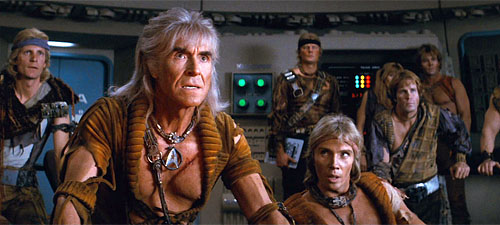 When Kirk arrives at the research station, Khan is ready, and cripples the Enterprise with a pre-emptive attack. Kirk pulls a trick to deactivate Reliant‘s shields and get a shot in, and the two ships withdraw. Kirk, McCoy, and Saavik check the research station and find dead scientists, barely alive Chekov and Terrell, and a transporter recently set to beam inside the nearby asteroid. Spock on board the Enterprise reports the transporters have died and Kirk asks how long until they are repaired. In a transparent piece of codespeak, Spock tells Kirk “hours would seem like days” and that they will be ready in two days. It’s kind of clever, since they know Khan will be listening in, but it’s a bit of a plothole that Khan (a genius, remember) can’t decipher the real meaning of this message.
When Kirk arrives at the research station, Khan is ready, and cripples the Enterprise with a pre-emptive attack. Kirk pulls a trick to deactivate Reliant‘s shields and get a shot in, and the two ships withdraw. Kirk, McCoy, and Saavik check the research station and find dead scientists, barely alive Chekov and Terrell, and a transporter recently set to beam inside the nearby asteroid. Spock on board the Enterprise reports the transporters have died and Kirk asks how long until they are repaired. In a transparent piece of codespeak, Spock tells Kirk “hours would seem like days” and that they will be ready in two days. It’s kind of clever, since they know Khan will be listening in, but it’s a bit of a plothole that Khan (a genius, remember) can’t decipher the real meaning of this message.
In the meantime, the landing party beams down inside the asteroid, finding a hollowed chamber. Carol’s son David attacks Kirk, thinking he’s behind the attack, but she calls him off. Chekov and Terrell reveal they are still under Khan’s mental command, and contact Khan, who beams up the Genesis device. Terrell kills a redshirt scientist who tries to jump him, then fights off the parasite’s influence and turns the phaser on himself. Chekov collapses and McCoy tends to him. Carol explains to Kirk that David is his son, and then they reveal an enormous cave in the asteroid, terraformed by Genesis. On cue, two hours later, Spock beams them aboard and the final showdown with Khan commences.
The Enterprise limps to the Mutara Nebula, which clouds ship’s sensors and gives them an even chance against the less damaged Reliant. Khan again plays against his alleged genius intellect by famously thinking “two dimensionally” as Spock points out. Kirk commands the recovered Chekov to pilot the Enterprise down, and they manage to get behind Khan this way and deliver a killing blow. Khan decides to take Kirk with him, activating the Genesis device in a ploy to convert the entire nebula and everything within it into a new planet. The Enterprise can’t get out without warp drive, and the engines can’t be fixed because of radiation flooding the engine chamber.
Unknown to Kirk, Spock races down the engineering. McCoy tries to stop him entering the chamber, but Spock nerve pinches him, then in an odd move grips the unconscious McCoy in the Vulcan mind meld grip and whispers, “Remember.” Spock then enters the chamber and performs the necessary repairs, allowing the ship to escape in the nick of time as the nebula implodes. Kirk breathes a sigh of relief, interrupted as he notices Spock is not on the bridge and by McCoy calling from engineering and saying to get down there. Kirk arrives in time for poignant last words as Spock dies on the other side of the clear radiation screen. After a moving funeral, they shoot his body into space in a torpedo casing over the new Genesis planet, presumably to burn up in re-entry.
 In the denouement, David and Kirk come to terms with their relationship. Then on the bridge, Kirk quotes the ending lines of A Tale of Two Cities, bookending this literary reference to Spock’s sacrifice to save his friends. The final shot is of the Genesis planet, on which we see Spock’s torpedo tube, apparently soft-landed. The famous “Space, the final frontier” speech is then delivered for the first time in the franchise by Leonard Nimoy.
In the denouement, David and Kirk come to terms with their relationship. Then on the bridge, Kirk quotes the ending lines of A Tale of Two Cities, bookending this literary reference to Spock’s sacrifice to save his friends. The final shot is of the Genesis planet, on which we see Spock’s torpedo tube, apparently soft-landed. The famous “Space, the final frontier” speech is then delivered for the first time in the franchise by Leonard Nimoy.
The revenge theme is what drives this film. And despite the more obvious use of A Tale of Two Cities, it is another book that forms the core of the film. As Chekov and Terrell are surveying the wreck of the Botany bay, we see a copy of Moby-Dick on a shelf. Khan is Captain Ahab, and Kirk is his white whale. The parallels are deliberately played up, including the final showdown game of cat and mouse in the Mutara Nebula between the Enterprise and Khan’s captured Reliant that echoes battle on the high seas. Khan’s last words are even a direct quote of Ahab’s. And in a piece of coincidence that couldn’t have been better if it was engineered, Ceti Alpha is the brightest star in the constellation of Cetus – the whale.
This film is so much better than Star Trek: The Motion Picture, in so many ways. The villain is more accessible, more real, more threatening, more of an actual villain. There’s real conflict. There’s more emotionally involving backstory, as Kirk faces up to old age, and to his past. There’s a young Kirstie Alley. There’s more quotable dialogue. There’s more intense drama and tension. There’s Starfleet uniforms that actually look good. I’ve seen some reports floating around the net that this used to be generally considered the best original cast Star Trek film, but that nowadays many people prefer VI: The Undiscovered Country. I went into this viewing open-minded, knowing I’d be reviewing both films eventually. But watching it again just makes me more certain that this one is the best. By far.
Tropes: Naive Newcomer, Unwinnable Training Simulation, Sealed Evil In A Can, Bus Crash, Best Served Cold, Orifice Invasion, Puppeteer Parasite, Technology Porn, Genesis Effect, Creating Life, Doomsday Device, Cryptic Conversation, Luke, You Are My Father, Ham To Ham Combat, Space Clouds, 2-D Space, Taking You With Me, Heroic Sacrifice, Outrun The Fireball, Anyone Can Die, Whole Plot Reference, Space Is An Ocean.
Body count: Peter Preston (killed in initial attack on Enterprise), 5+ scientists (killed by Khan’s mob), 1 scientist (phasered by Captain Terrell), Captain Terrell (phasers self), Joachim (victim of Kirk’s attack on Reliant), Khan (Genesis explosion), all Khan’s followers (Genesis explosion or final attack), Spock (selfless sacrifice).

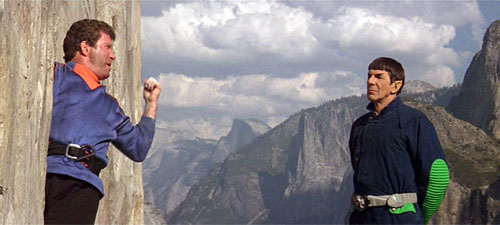 Well, here we are. I actually had to go out to a shop and buy a copy of
Well, here we are. I actually had to go out to a shop and buy a copy of 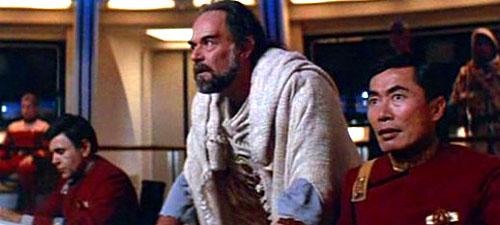 We’re then treated to a shot of a Klingon vessel blowing up an Earth space probe, apparently just for the heck of it. The probe looks remarkably like Voyager, bringing up echoes of V-ger from the first film. The Klingon commander (who is a glam rock star,
We’re then treated to a shot of a Klingon vessel blowing up an Earth space probe, apparently just for the heck of it. The probe looks remarkably like Voyager, bringing up echoes of V-ger from the first film. The Klingon commander (who is a glam rock star, 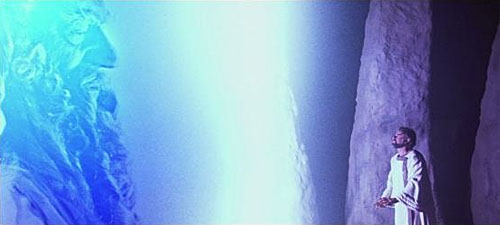 Sybok is taking the ship to the centre of the galaxy, to find the Vulcan legendary world of Sha Ka Ree, where he hopes to find God. They get there and meet a being who looks and sounds like God, and asks to be taken away on their ship to spread his word throughout the galaxy. Kirk asks the only memorable line of the film: “Excuse me,
Sybok is taking the ship to the centre of the galaxy, to find the Vulcan legendary world of Sha Ka Ree, where he hopes to find God. They get there and meet a being who looks and sounds like God, and asks to be taken away on their ship to spread his word throughout the galaxy. Kirk asks the only memorable line of the film: “Excuse me, 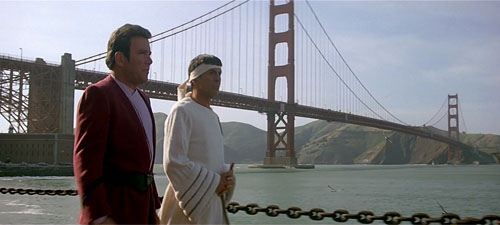 Like the movie before it,
Like the movie before it, 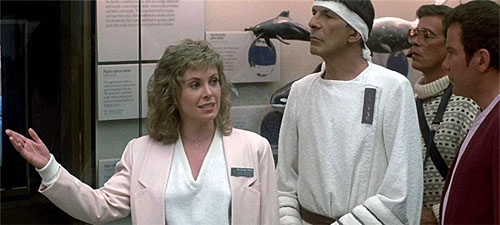 We are treated to some trippy mind-screw hallucinatory images as the Klingon ship slingshots around the sun and is flung back to… 1986! Uhura reports that she is “receiving whalesong!” One wonders how the whales are transmitting it into space – presumably through the same means they use to communicate with the mysterious probe’s civilisation. They land in Golden Gate Park in San Francisco, with the ship cloaked – thus explaining why they had to retain the Klingon ship, since Federation vessels don’t have cloaking technology. Interestingly, in the previous movie, the cloaking device on this same ship produced a rippling effect against the background stars in space that allowed Sulu to see the ship anyway, but now it produces complete and utterly flawless invisibility. Presumably Scotty did some of his magical engineering tweaks on it to improve it.
We are treated to some trippy mind-screw hallucinatory images as the Klingon ship slingshots around the sun and is flung back to… 1986! Uhura reports that she is “receiving whalesong!” One wonders how the whales are transmitting it into space – presumably through the same means they use to communicate with the mysterious probe’s civilisation. They land in Golden Gate Park in San Francisco, with the ship cloaked – thus explaining why they had to retain the Klingon ship, since Federation vessels don’t have cloaking technology. Interestingly, in the previous movie, the cloaking device on this same ship produced a rippling effect against the background stars in space that allowed Sulu to see the ship anyway, but now it produces complete and utterly flawless invisibility. Presumably Scotty did some of his magical engineering tweaks on it to improve it.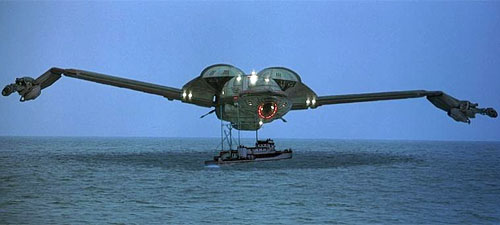 There they release the whales into San Francisco Bay to
There they release the whales into San Francisco Bay to 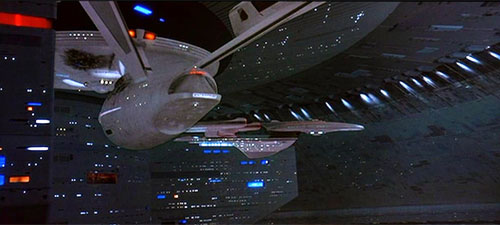
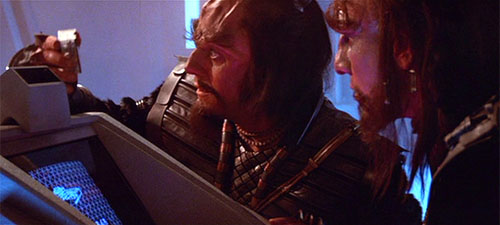 And here’s the plot hole in the film. Kirk appeals to Admiral Morrow to get back Enterprise, but
And here’s the plot hole in the film. Kirk appeals to Admiral Morrow to get back Enterprise, but 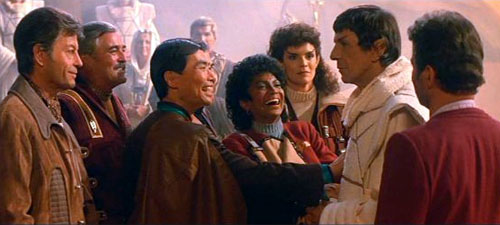 They find the Klingons and Saavik and Spock. Kruge beams down to engage Kirk in a clifftop fistfight, in which Kirk kicks Kruge off the cliff and he
They find the Klingons and Saavik and Spock. Kruge beams down to engage Kirk in a clifftop fistfight, in which Kirk kicks Kruge off the cliff and he  Ah, now here we have something. Star Trek II: The Wrath of Khan is what really drove me to continue this series of reviews into the films. It is widely regarded as the best of the original cast Star Trek films. Watching it again, I am reminded forcefully why this is the case.
Ah, now here we have something. Star Trek II: The Wrath of Khan is what really drove me to continue this series of reviews into the films. It is widely regarded as the best of the original cast Star Trek films. Watching it again, I am reminded forcefully why this is the case. When Kirk arrives at the research station, Khan is ready, and cripples the Enterprise with a pre-emptive attack. Kirk pulls a trick to deactivate Reliant‘s shields and get a shot in, and the two ships withdraw. Kirk, McCoy, and Saavik check the research station and find dead scientists, barely alive Chekov and Terrell, and a transporter recently set to beam inside the nearby asteroid. Spock on board the Enterprise reports the transporters have died and Kirk asks how long until they are repaired. In a transparent piece of
When Kirk arrives at the research station, Khan is ready, and cripples the Enterprise with a pre-emptive attack. Kirk pulls a trick to deactivate Reliant‘s shields and get a shot in, and the two ships withdraw. Kirk, McCoy, and Saavik check the research station and find dead scientists, barely alive Chekov and Terrell, and a transporter recently set to beam inside the nearby asteroid. Spock on board the Enterprise reports the transporters have died and Kirk asks how long until they are repaired. In a transparent piece of  In the denouement, David and Kirk come to terms with their relationship. Then on the bridge, Kirk quotes the ending lines of A Tale of Two Cities, bookending this literary reference to Spock’s sacrifice to save his friends. The final shot is of the Genesis planet, on which we see Spock’s torpedo tube, apparently soft-landed. The famous “Space, the final frontier” speech is then delivered for the first time in the franchise by Leonard Nimoy.
In the denouement, David and Kirk come to terms with their relationship. Then on the bridge, Kirk quotes the ending lines of A Tale of Two Cities, bookending this literary reference to Spock’s sacrifice to save his friends. The final shot is of the Genesis planet, on which we see Spock’s torpedo tube, apparently soft-landed. The famous “Space, the final frontier” speech is then delivered for the first time in the franchise by Leonard Nimoy.